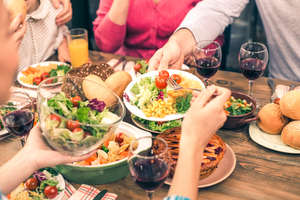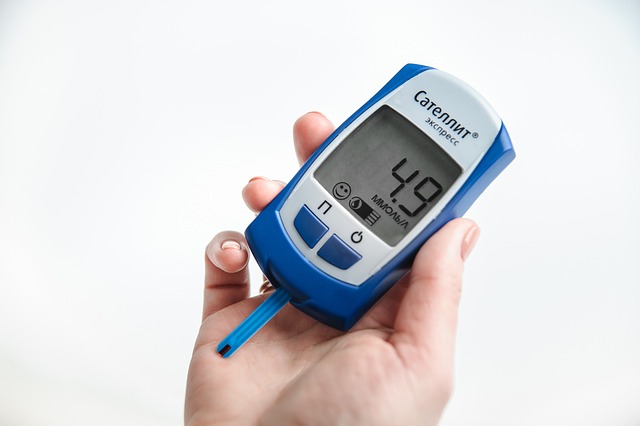In this article:
- Purchasing healthy foods when you go grocery shopping can enable you to make nutritious meals that can support your weight goals.
- It can be easier to purchase healthy foods when you know how to reduce costs.
- Catching good deals and prepping your own food are some strategies.
- Lark can help you eat healthy and hit your weight goals. Your Lark coach is available 24/7 for personalized help with nutrition, physical activity, and more.
What you eat is one of the most important factors in managing weight. You get more control over what you eat and how much you eat when you prepare your own food more often instead of eating out. That means you will need to go grocery shopping.
What should you buy? How do you find the healthy foods at prices you can afford so you can follow a healthy meal plan? Here is some guidance to help you manage weight when you shop for groceries.
Strategies for Lowering Costs
“I can’t afford to eat healthy!”
Do you use cost as an excuse not to eat healthy? It is not your imagination if you find that healthy eating costs more. Research shows that eating healthy costs $1.50 more per person per day on average. That works out to $500 per year, or $2,000 per year for a family of four. Not only that, but in recent years, the prices of healthy foods have increased more than those of unhealthy foods.
On the other hand, health problems related to unhealthy eating can be expensive. Over time, you may actually save money by buying healthy foods and reducing health risks related to unhealthy eating. In addition, it’s usually healthier to eat at home, and you can save money by eating at home more often and eating out less often.
There are other steps you can take to make healthy eating more affordable.
Catch the Deals
There are a few tried and true ways to pay less for groceries. Read the sales flyers to catch the weekly sales. The ads are usually available online, so do not worry if they do not come in the mail. Also, clip coupons or load them to your smartphone or store club card. When they are on sale, stock up on non-perishable items such as canned and frozen goods and pantry staples
Be somewhat flexible with your shopping list when it makes sense. Use your list to stick to healthy items, but be open to simple swaps. For example, if all you need is a side dish, you can swap out cauliflower if it’s too expensive. Instead, find another option that’s on sale, whether it’s broccoli, green beans, zucchini, or another non-starchy vegetable.
Buying in Bulk and Cooking in Batches
The exact same food can have different prices depending on how you buy it. Often, large packages are cheaper per serving than smaller packages of food. If you opt to save money by buying family or value packs, or stocking up when items are on sale, you can avoid waste by freezing them or by cooking big batches of food to use later in the week. This is also a great time-saver. The following are good big-batch dishes to make.
- Chili with vegetables, beans, and ground turkey or soy.
- Broth-based soup with vegetables and protein such as chicken, beans, or turkey meatballs.
- Casseroles with a protein such as chicken, tuna, beans, or lean ground turkey, vegetables, a starch such as brown rice or whole-wheat pasta, and seasoning such as low-sodium bouillon or spices.
- Breakfast muffins or casseroles with eggs, cheese, and vegetables such as spinach, tomatoes, zucchini, broccoli, and/or onions.
- You can also cook large batches of chicken, fish, beans, or other protein and freeze them in small batches to defrost later when you need a quick dinner.
In minutes, you can throw together dishes such as chicken with vegetables, tomato sauce, and whole-wheat spaghetti, fish stir-fry with frozen vegetables, or taco salad with beans and low-fat cheese.
Similarly, multi-serving packages of snack foods can cost several times less per serving than single-serving packs. You can buy large packages of nuts, and even cheese. If you have trouble with portion control, just pack them into single-serving packages when you get home.
Prep Your Own Food
Supermarkets and food manufacturers charge a premium for food that is pre-prepped. The more you can do yourself, the less expensive your food will be. Vegetables and fruit can be one-third the cost or less when you purchase them whole rather than cut and ready-to-eat.
The following choices can help you save money.
- Wash, peel, and cut whole fruit and vegetables instead of buying them peeled, washed, and cut.
- Buy heads of lettuce and bottles of salad dressing instead of bagged salad with small packets of dressing.
- Cook dried beans and lentils instead of purchasing canned options.
- Purchase raw skinless chicken breast instead of a rotisserie chicken.
As a bonus, whole versions of produce have a longer shelf life than pre-cut options.
Meal Planning
Planning your weekly meals ahead of time can help you create your shopping list. You can plan your meals for the week (or however often you go grocery shopping). Then see which ingredients you already have at home, and which you need to purchase.
Meals for the Week
In the following sample menu for the week, many items are used more than once to reduce the amount of ingredients you need to buy. In the chart:
*means that you may need to purchase that item.
** means that it may be a staple that you may have at home or may need to replenish when you shop - check before you go to the store.
Healthy Snacks
Snacks may be pre-scheduled, or they may be impromptu. Either way, you may want to have some quick and easy snack options on hand for when you get hungry. As you make your grocery list, consider some ready-to-eat, easily portable items such as the following.
- Lowfat string cheese sticks
- Nuts, peanuts, and/or sunflower seeds
- Whole fruit such as apples, bananas, and oranges
- Baby carrots and mini bell peppers
- Lowfat microwave popcorn
- Plain nonfat yogurt in single-serve containers
- Whole-grain crackers
- You may also want to buy some eggs to boil and keep in the fridge for when you need them.
Foods to Limit as You Shop
- Freezer - ice cream, most frozen dinners (if you get one, look for one with a lean protein such as non-breaded chicken or shrimp, vegetables, and beans, sweet potatoes, or a whole grain such as brown rice), fried potatoes, chicken nuggets and other breaded foods, breakfast sandwiches with bacon or sausage or on croissants or bagels, pizza
- Meat and deli - sausage, fatty red meat, processed luncheon meats, prepared mayo-laden salads, lunch kits with processed meat and crackersBakery section - cake, cookies, pie, doughnuts, white bread and bagels
- Pantry - sweetened breakfast cereal and oatmeal, instant meals such as mac and cheese, canned chili, canned fruit with sugar added, toaster pastries, syrup, jam
- Dairy - butter, margarine (or choose trans fat-free), pudding, sugar-sweetened flavored yogurt, sweetened almond or soy milk
- Snack aisle - white crackers and pretzels, potato, tortilla, and corn chips, cookies, rice cakes, dried fruit, granola barsCash register - candy, single-serve sodas
- Beverages - fruit drinks, fruit juice, soda, energy drinks, sports drinks, coffee creamer
At the Store
Having a shopping list is an important part of your plan for healthy grocery shopping. You can strengthen your plan by knowing what you will do when you get to the store. Think ahead about which aisles you will shop, and how you can use labels to help you. Also, do not go on an empty stomach, as you will be more tempted to buy high-calorie snacks.
Healthier Aisles
The traditional layout for supermarkets places produce, dairy products, and fresh meat and fish along the outside aisles of the store; that is, the sides and back of the store. Inner aisles may be filled with more processed foods, so you might want to make sure you do the perimeter thoroughly before venturing to the inner part of the store.You can use the same principle even if your supermarket does not have the traditional layout with produce on the perimeter. Basically, avoid problem areas, whatever these may be for you. If potato chips trigger cravings for you, do not go down the snack foods aisle. If you cannot resist grabbing a cookie sample when you pass the bakery, skip that area. If the ready-to-eat pizza or ribs smell too good to pass up, skip the prepared foods section.
Read Labels
Food labels can provide valuable information about the ingredients and nutrients in foods. You can use labels to help you choose more nutritious foods when you go grocery shopping.
- They can help guide you towards more nutritious types of foods.
- They can help you decide which of two apparently similar foods or brands is healthier.
- Nutrition facts panels contain a lot of information, but you do not have to read every single line for every single food.
When appropriate, you might want to look for foods that are lower in:
- Calories - for weight control.
- Sugars - for blood sugar control.
- Saturated fat - for weight control, blood sugar control, and heart health.
- Sodium - for blood pressure control and often as an indicator of processed foods.
You also generally want foods that are higher in:
- Protein - for hunger control and blood sugar control.
- Dietary fiber - for hunger control, blood sugar control, and heart health.
Many foods do not have labels. In fact, the foods that make up a large proportion of your diet may not be packaged. These are, of course, vegetables, fruits, and proteins such as chicken breast and lean ground turkey. You can be confident that these kinds of foods are good choices, so it is okay to purchase them even though they have no nutrition facts panel.
Become a Pro!
If all this sounds like a lot, you are right...sort of. There is a lot to remember, from making a list to checking the weekly ads to reading labels in the store. On the other hand, it can become second nature if you practice it.
Lark can help you lose weight and keep it off as you shop for healthy foods and use them in your nutritious meals and snacks. Your Lark coach is available 24/7 for personalized and compassionate coaching on healthy eating, physical activity, stress management, and sleep. Lark can help you make healthy choices and establish habits that fit into your lifestyle so you can lose weight and keep it off with or without GLP-1 medications.
Click here to see if you may be eligible to join Lark today!











.webp)






